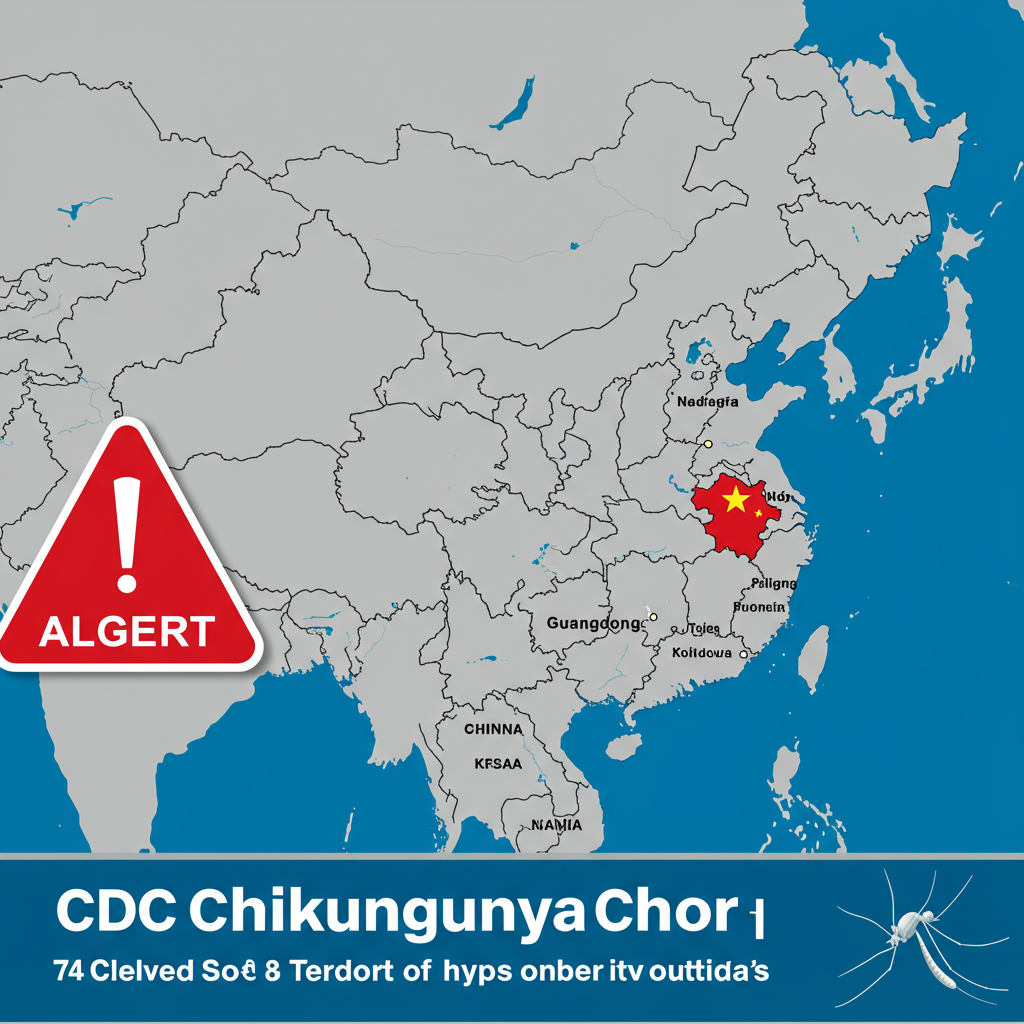The U.S. Centers for Disease Control and Prevention (CDC) has issued a critical travel warning for individuals heading to parts of southeast China. This alert comes as the region grapples with a significant outbreak of chikungunya, a mosquito-borne illness. The warning, released on August 5, 2025, emphasizes the need for enhanced precautions, particularly for travelers visiting Guangdong province, where most cases are concentrated in the city of Foshan. Understanding the risks and implementing preventive measures is crucial for protecting your health during international travel.
What is Chikungunya and How Does it Spread?
Chikungunya is a viral disease primarily transmitted to humans through the bite of infected female mosquitoes. The main culprits are the Aedes aegypti and Aedes albopictus species. These aggressive mosquitoes are also notorious carriers of other viruses like dengue and Zika, making effective mosquito bite prevention paramount. The name “chikungunya” itself is derived from a Kimakonde word, meaning “that which bends up,” a poignant reference to the stooped posture often adopted by those suffering from the severe joint pain characteristic of the illness.
Once bitten by an infected mosquito, symptoms typically emerge within three to seven days. The virus incubates during this period before manifesting. While most individuals recover within approximately one week, the disease can be debilitating. There is currently no specific antiviral treatment for chikungunya, meaning care focuses on managing symptoms to alleviate discomfort.
Recognizing Chikungunya Symptoms and Risk Factors
The CDC highlights a range of symptoms associated with chikungunya infection. These commonly include:
Fever: Often sudden onset.
Joint Pain: This is the hallmark symptom and can be severe, sometimes lasting for months or even years after the initial acute phase.
Headache: A frequent accompanying symptom.
Muscle Pain: General body aches and soreness.
Rash: A skin eruption may appear.
Joint Swelling: Inflammation around the affected joints.
While generally not fatal, chikungunya can significantly impact a person’s quality of life due to persistent pain. Certain groups face a heightened risk of developing severe illness. These vulnerable populations include newborns, older adults, and individuals with pre-existing medical conditions such as heart disease and diabetes. Although fatalities are rare, typically accounting for about 0.01% of global cases annually, the severe and prolonged joint pain can be a major concern.
The Current Chikungunya Outbreak in China
Southern China is experiencing one of its most notable chikungunya outbreaks in nearly two decades. The epicenter of this surge is Foshan, a major manufacturing hub in Guangdong province. Data from China’s National Health Commission revealed 2,940 new local cases in Guangdong province between July 20 and July 26, 2025. Foshan alone accounted for approximately 60% of the initially reported cases, with total documented cases in Guangdong exceeding 6,500 by July 30. More broadly, over 7,000 cases have been reported in Foshan, with sporadic infections noted in nearby cities like Guangzhou, Shenzhen, Dongguan, and Zhongshan.
Chinese authorities have largely classified these cases as mild, with no severe illnesses or deaths reported during this period. However, the scale of the outbreak prompted a visit from Vice Premier Liu Guozhong, who urged stringent port health quarantine measures and intensified mosquito control efforts. The earliest symptomatic case in this specific outbreak was identified on June 16, underscoring the rapid spread. Hong Kong reported its first imported case since 2019 on August 4, involving a child who had recently traveled from Guangdong. This highlights the potential for internationally mobile travelers to spread the virus further.
Global Context and Historical Spread
Chikungunya is not new to the world stage. The virus was first identified in Tanzania in 1952 by the World Health Organization (WHO). Since 2004, there has been a concerning trend of more frequent and geographically widespread outbreaks. The disease has now been reported across Asia, Africa, Europe, and both North and South America.
Notable past outbreaks include a massive event in East Africa in 2004, affecting 70% of Lamu Island’s population in Kenya before spreading to Mauritius and Seychelles. India also experienced a widespread outbreak in 2006, with nearly 1.3 million suspected cases. More recently, the French island territory of La Réunion has seen tens of thousands of cases. In the U.S., locally acquired cases were first reported in 2014, leading to chikungunya becoming a nationally notifiable condition by 2015. China has also dealt with imported cases previously, including clusters in Guangdong in 2010 and Yunnan in 2019. Public health officials attribute the current 2025 outbreak to imported cases, exacerbated by the presence of local Aedes mosquito populations, which sustains local transmission cycles.
Prevention and Control Strategies
Given the absence of a specific cure, prevention remains the most effective defense against chikungunya. For travelers, the CDC advises adopting enhanced protective measures against mosquito bites. These practical steps can significantly reduce your risk of infection:
Insect Repellents: Use EPA-registered insect repellents containing DEET, picaridin, IR3535, oil of lemon eucalyptus (OLE), para-menthane-diol (PMD), or 2-undecanone. Always follow product label instructions.
Protective Clothing: Wear long-sleeved shirts and long pants, especially during daytime hours when Aedes mosquitoes are most active.
Accommodations: Stay in lodging with air conditioning or well-screened windows and doors to keep mosquitoes out.
Vaccination: For individuals traveling to areas experiencing chikungunya outbreaks, vaccination is recommended. There are currently two approved chikungunya vaccines available in the United States. Pregnant individuals are advised to reconsider travel to affected areas, especially if close to their delivery date, due to the risk of transmitting the virus to their baby.
Chinese authorities are also employing a multi-faceted approach to combat the spread. Drawing lessons from their “COVID-19 playbook,” they are implementing measures such as mass testing, isolation of infected residents, and disinfection of entire neighborhoods. Foshan authorities have designated numerous hospitals for treatment and increased mosquito-proof isolation beds. Unconventional solutions are also being explored, including deploying larvae-eating fish into lakes (which serve as mosquito breeding grounds) and releasing swarms of “elephant mosquitoes,” a species that does not bite humans but preys on the Aedes mosquitoes that transmit the virus. These efforts are complicated by the current flood and typhoon seasons, which inherently boost mosquito activity.
Frequently Asked Questions
What is Chikungunya and why is it a concern in China right now?
Chikungunya is a viral illness transmitted by mosquito bites, primarily causing fever and severe joint pain, along with headaches, muscle aches, and rash. It’s a concern in China because Guangdong province, particularly Foshan city, is experiencing a significant outbreak as of August 2025. Thousands of cases have been reported, prompting a travel warning from the U.S. CDC due to the potential for international spread and the debilitating nature of its symptoms, especially the prolonged joint pain.
What specific steps should travelers take to avoid Chikungunya in affected areas?
Travelers to regions with chikungunya outbreaks, like Guangdong province in China, should take enhanced precautions against mosquito bites. This includes using EPA-registered insect repellents, wearing long-sleeved shirts and long pants to cover exposed skin, and staying in accommodations with air conditioning or screened windows and doors. The CDC also recommends vaccination against chikungunya for those visiting outbreak areas, noting that two approved vaccines are available in the United States.
How is China responding to the Chikungunya outbreak, and what makes this outbreak significant?
Chinese authorities are implementing robust measures to control the chikungunya outbreak, including mass testing, isolation of infected residents, and large-scale disinfection efforts, drawing on strategies used during the COVID-19 pandemic. They are intensifying mosquito control by deploying larvae-eating fish and “elephant mosquitoes” to target Aedes populations. This outbreak is significant due to its rapid spread, concentrated nature in Foshan (over 7,000 cases), and the potential for international transmission, as evidenced by imported cases in Hong Kong. It highlights the challenges of vector-borne diseases in interconnected global travel.
Staying Vigilant and Prepared
The chikungunya outbreak in China serves as a powerful reminder of the persistent global challenge posed by mosquito-borne diseases. While authorities in China are actively working to contain the spread, and global health organizations monitor the situation, individual awareness and preventive action remain the strongest defense. By understanding the risks, recognizing symptoms, and diligently applying preventive measures, travelers can significantly reduce their exposure. Consult your healthcare provider before international travel for personalized advice and consider vaccination if traveling to high-risk regions. Your proactive steps contribute to both your safety and broader public health.




